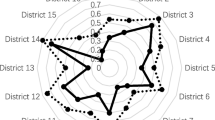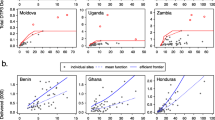Abstract
An aim of vaccination programs is near-complete coverage. One method for achieving this is for health facilities providing these services to operate frequently and for many hours during each session. However, if vaccine vials are not fully used, the remainder is often discarded, considered as waste. Without an active appointment schedule process, there is no way for facility staff to control the stochastic demand of potential patients, and hence reduce waste. And yet reducing the hours of operation or number of sessions per week could hinder access to vaccination services. In lieu of any formal system of controlling demand, we propose to model the optimal number of hours and sessions in order to maximize outputs, the number and type of vaccines provided given inputs, using Data Envelopment Analysis (DEA). Inputs are defined as the amount of vaccine wastage and the number of full-time equivalent staff, size of the facility, number of hours of operation and the number of sessions. Outputs are defined as the number and type of vaccines aimed at children and pregnant women. This analysis requires two models: one DEA model with possible reallocations between the number of hours and the number of sessions but with the total amount of time fixed and one model without this kind of reallocation in scheduling. Comparing these two scores we can identify the “gain” that would be possible were the scheduling of hours and sessions modified while controling for all other types of inefficiency. By modeling an output-based model, we maintain the objective of increasing coverage while assisting decision-makers determining optimal operating processes.
Similar content being viewed by others
References
England, S. et al. (2001). The Evidence Base for Interventions to Reduce Mortality from Vaccine-Preventable Diseases in Low and Middle-Income Countries. CMH Working Paper Series. Vol. Paper No. WG5: 10.
Expanded Program on Immunization National Plan of action 2001-2005. Government of Bangladesh.
Färe, R., S. Grosskopf and C. A. K. Lovell. (1994). Production Frontiers. Cambridge: Cambridge University Press.
Farrell, M. J. (1957). “The Measurement of Productive Efficiency.” Journal of the Royal Statistical Society, Series A (General) 120, 253–281.
Rappouli, R, H.I. Miller and S. Falkow. (2002). “The Intangible Value of Vaccination.” Science 297, 937–939.
Walker, D., S. Khan, S. M. Akramuzzaman et al. (2000). Cost-Effectiveness of Measles Control in Urban Dhaka, Bangladesh. Geneva: Final Report to WHO.
World Bank. (1993). World Development Report 1993. Investing in Health. Oxford: Oxford University Press.
World Health Organization. Expanded Programme on Immunization (1999). WHO-UNICEF policy statement on the use of vaccine vial monitors in immunization services. Geneva: WHO, (document WHO/V & B/99.18); www.who.int/vaccines-documents/DocsPDF99/www9928.pdf
World Health Organization. (2000). WHO Policy Statement: The Use of Opened Multi-Dose Vials of Vaccine in Subsequent Immunization Sessions. Geneva: Department of Vaccines and Biologicals, WHO, (document WHO/V & B/00.09); www.who.int/vaccines-documents/DocsPDF99/www9924.pdf
Author information
Authors and Affiliations
Rights and permissions
About this article
Cite this article
Dervaux, B., Leleu, H., Valdmanis, V. et al. Parameters of Control when Facing Stochastic Demand: A DEA Approach Applied to Bangladeshi Vaccination Sites. International Journal of Health Care Finance and Economics 3, 287–299 (2003). https://doi.org/10.1023/A:1026021407108
Issue Date:
DOI: https://doi.org/10.1023/A:1026021407108




